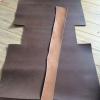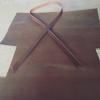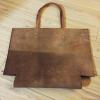-
Posts
193 -
Joined
-
Last visited
Content Type
Profiles
Forums
Events
Blogs
Gallery
Everything posted by grmnsplx
-

How To Finish Edges Of Goatskin Leather ?
grmnsplx replied to phamcaovien's topic in Getting Started
Yup. Edgepaint. -
Ah, I missed that part. Thanks!
-
Some of you coad eggs are different shades. Are those different ratios of resin to wax?
-
badass.
-
I'll have to try this. Thanks!
-

How To Finish Edges Of Goatskin Leather ?
grmnsplx replied to phamcaovien's topic in Getting Started
I have had good results burnishing goat skin. It depends on the tannage. The image attached is of a goatskin wallet. That top piece - a cash strap - has been dyes and burnished. I think it's a decent burnish. -
@Matt T Are you going to get any 1mm slam thread? Thanks!
-

How To Finish Edges Of Goatskin Leather ?
grmnsplx replied to phamcaovien's topic in Getting Started
Is it veg or chrome? Either way, one option if to turn the edge. -
I don't agree. Or, at least, the semantics are important. The waterstains are an acrylic pigment. They do not penetrate. The water dyes are more standard dye compounds in an alcohol/water solution. These are intended to penetrate the leather. The acrylic dyes / "waterstains" are closer to a paint than a dye. It's funny. Fiebings has an "Acrylic Dye" and a "Leather Stain". These are roughly equivalent to Tandy's Eco-Flo "Waterstain" (made by Fenice) and water based "Leather Dye" (made by Fiebings). Note that Fiebing's description of their "Acylic Dye" is "Quick drying, long lasting leather paint for color coating smooth leather surfaces. Flexible and water resistant. Makes for a great edge finish too." Tandy's water based dye: "Eco-Flo Leather Dye is a water based, low V.O.C., penetrating leather dye for use on natural veg-tanned tooling leather. It's great for overall solid color dyeing or background dyeing. Also use for floral, figure and pictorial coloring." Fiebing's water based dye ("leather stain"): "Non-flammable, penetrating dye that provides long lasting, lustrous color. Can be applied with a wool dauber, spray gun or dipped. Can be blended together to create even more varieties. " I've used the Eco-flo waterstains and the "water based" dyes and they are completely different. The water stain goes on super even, super flat, does not penetrate and leave your piece pretty stiff and inflexible. The dyes are harder to get even, they penetrate and are not very colour-fast. The piece takes a while to dry and it will be a bit stiff afterwards. Given a choice, I would use an "oil"/spirit dye over either.
-

How Do I Finish Leather But Keep The Leather Smell?
grmnsplx replied to Chief Filipino's topic in How Do I Do That?
Have you tried Fiebings "Bag Kote"? I got some last weekend and it seems pretty good. -
I recently got a request for a tote bag with a divider. I'm not really sure how best to accomplish this. In the few totes that I have made, I used a one piece construction something that looks kind of like this: http://4.bp.blogspot.com/-32nZzJee7hA/VMgXVc9pdFI/AAAAAAAAIak/4faAJ5k2vRU/s1600/bag%2Bpattern.png I've attached images of my most recent bag. Anyway, how best to add a divider in the middle evades me. I have several ideas but none that I really like. My best idea so far is to make the body of the bag in two pieces. stitch the divider piece to the bottom and maybe stitch the bottom again in order to hide the divider edge. Then stitch the sides together with the divider in there. Then stitch the base. When the bag is done the edges will be outside the bag so not turned like my other totes. Another possibility is to simply make a bag with two gussets. Would live to hear your ideas. Thanks!
-
Got a pic?
-
I watched a video of a very similar repair last week:
- 6 replies
-
- louis vuitton
- relining purse
-
(and 2 more)
Tagged with:
-
hah! I got it. "diethylene glycol monoethyl ether" is synonymous with "2-(2-Ethoxyethoxy)ethanol" It's Tandy's "water based" Eco-Flo leather dye - which is made by Fiebings. http://www.tlfsafety.com/PdfFiles/2600-16%20GHS-EN_MSDS.pdf http://www.weaverleather.com/Documents/MSDS/Fiebings-Leather-Stain.pdf
-
Interesting. Looks like it's a "diethylene glycol monoethyl ether" dye. Just means the use diethylene glycol monoethyl ether as a solvent for they dye complexes. Looks like it's a pretty common solvent for wood stains, paints, etc. The pro oil dyes also have some diethylene glycol monoethyl ether, but there are some other ethers, alcohols, some benzene and other stuff in there as well. The spirit dyes are similar - diethylene glycol monoethyl ether and some alcohols mainly Hard to say what it's like to use. I guess you'll just have to experiment. I wonder if it's the same as Tandy's new Oil dyes? (Fiebings makes a lot of products for Tandy) It seems that with tightening regulations, it getting harder to make and ship some products with chemicals like benzine around so companies like Tandy and Fiebings are making new products with different solvent blends.
-

Brass Cartridges Turning Green
grmnsplx replied to x101airborne's topic in Gun Holsters, Rifle Slings and Knife Sheathes
The saddle soap is basic and would contribute to the patina on your brass cartridges. -
According to RML, Niwa leathers uses it and his stuff looks fantastic. http://www.niwaleathers.com/
-
Are you using Tandy's waterstain to colour your leather? That's what it looks like. This stuff really stiffens your leather - the surface at least. It also doesn't penetrate. Since the leather is stiff, when you drive the chisel (or awl through), you can crack and tear the surface making your holes look messy. And since the stain doesn't penetrate, the uncoloured leather inside the hole is quite visible. You could try softening the leather with some oil after staining. And maybe consider a different method of colouring your leather.
-
@HondoMan if you are following SmokeyPoint's method, then there is now way your thread should be breaking. Can you try breaking your thread with your bare hands? Tiger thread is super strong. It should not break. If you can break it, then it's not Tiger thread, or it's a terrible batch, or it has been damaged by a solvent or heat.







